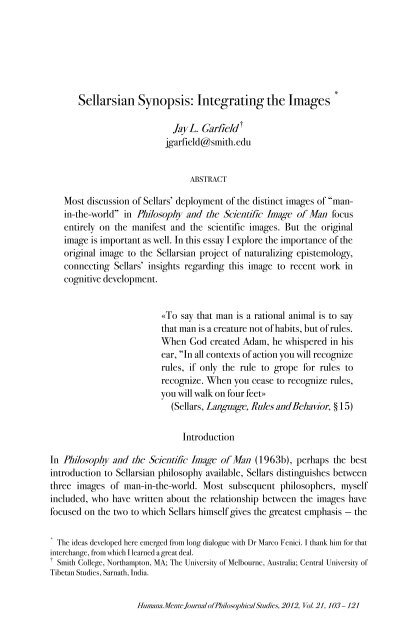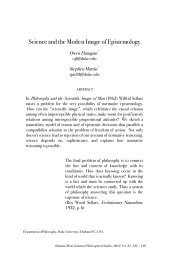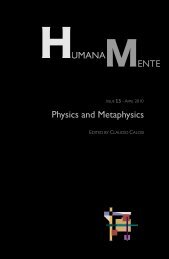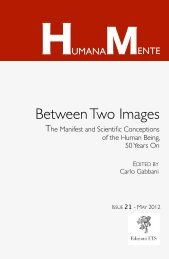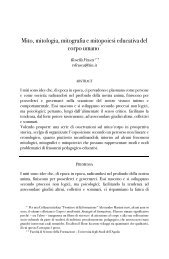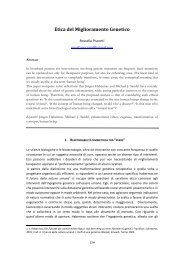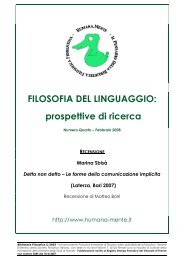Sellarsian Synopsis: Integrating the Images * - Smith College
Sellarsian Synopsis: Integrating the Images * - Smith College
Sellarsian Synopsis: Integrating the Images * - Smith College
You also want an ePaper? Increase the reach of your titles
YUMPU automatically turns print PDFs into web optimized ePapers that Google loves.
<strong>Sellarsian</strong> <strong>Synopsis</strong>: <strong>Integrating</strong> <strong>the</strong> <strong>Images</strong> *<br />
Jay L. Garfield †<br />
jgarfield@smith.edu<br />
ABSTRACT<br />
Most discussion of Sellars’ deployment of <strong>the</strong> distinct images of “manin-<strong>the</strong>-world”<br />
in Philosophy and <strong>the</strong> Scientific Image of Man focus<br />
entirely on <strong>the</strong> manifest and <strong>the</strong> scientific images. But <strong>the</strong> original<br />
image is important as well. In this essay I explore <strong>the</strong> importance of <strong>the</strong><br />
original image to <strong>the</strong> <strong>Sellarsian</strong> project of naturalizing epistemology,<br />
connecting Sellars’ insights regarding this image to recent work in<br />
cognitive development.<br />
«To say that man is a rational animal is to say<br />
that man is a creature not of habits, but of rules.<br />
When God created Adam, he whispered in his<br />
ear, “In all contexts of action you will recognize<br />
rules, if only <strong>the</strong> rule to grope for rules to<br />
recognize. When you cease to recognize rules,<br />
you will walk on four feet»<br />
(Sellars, Language, Rules and Behavior, §15)<br />
Introduction<br />
In Philosophy and <strong>the</strong> Scientific Image of Man (1963b), perhaps <strong>the</strong> best<br />
introduction to <strong>Sellarsian</strong> philosophy available, Sellars distinguishes between<br />
three images of man-in-<strong>the</strong>-world. Most subsequent philosophers, myself<br />
included, who have written about <strong>the</strong> relationship between <strong>the</strong> images have<br />
focused on <strong>the</strong> two to which Sellars himself gives <strong>the</strong> greatest emphasis — <strong>the</strong><br />
* The ideas developed here emerged from long dialogue with Dr Marco Fenici. I thank him for that<br />
interchange, from which I learned a great deal.<br />
†<br />
<strong>Smith</strong> <strong>College</strong>, Northampton, MA; The University of Melbourne, Australia; Central University of<br />
Tibetan Studies, Sarnath, India.<br />
Humana.Mente Journal of Philosophical Studies, 2012, Vol. 21, 103 – 121
104 Humana.Mente — Issue 21 — May 2012<br />
manifest and <strong>the</strong> scientific — in <strong>the</strong> quest ei<strong>the</strong>r to give one precedence over <strong>the</strong><br />
o<strong>the</strong>r (Churchland, 1986) or to vindicate a binocular vision (Garfield, 1988;<br />
deVries, 2005; Rosenberg, 2007). But <strong>the</strong>re is a third image in play as well,<br />
one to which Sellars himself gives relatively less attention, and which his<br />
successors have ignored almost entirely — <strong>the</strong> original image. This is<br />
unfortunate, for <strong>the</strong> project of naturalizing epistemology on <strong>Sellarsian</strong> lines,<br />
and making sense of <strong>the</strong> locus of normativity in <strong>the</strong> natural world, requires<br />
attention to all three images. In <strong>the</strong> present essay I will take Sellars’ vision<br />
beyond stereoscopy, bringing all three images into play in <strong>the</strong> quest for an<br />
epistemology fully naturalized on <strong>Sellarsian</strong> lines, consistent with evidence<br />
from contemporary developmental and cognitive psychology.<br />
The manifest image is <strong>the</strong> view of <strong>the</strong> world and of our place in it delivered<br />
by sophisticated common sense. It is <strong>the</strong> view that philosophical speculation<br />
attempts to refine. Most importantly, it is <strong>the</strong> image in which we are present as<br />
persons, beings who institute and respect norms in our thought, action and<br />
social arrangements, in which meaning emerges as a property of language and<br />
thought, and in which this normativity and meaning emerges in <strong>the</strong> context of a<br />
natural world that is in general governed by purely descriptive natural laws, and<br />
which is in general devoid of semantic content.<br />
The scientific image is <strong>the</strong> world as our best science represents it. It is <strong>the</strong><br />
world of microphysics, of cosmology, of chemistry and biology. It is a world of<br />
natural phenomena governed by natural law. Most importantly, <strong>the</strong> scientific<br />
image is an image devoid of persons, devoid of normativity, and devoid of<br />
meaning. In this image we have been explained away through <strong>the</strong> categories of<br />
<strong>the</strong> life and physical sciences in which <strong>the</strong> categories of normativity and<br />
meaning are not to be found. These images are, although from <strong>the</strong> perspective<br />
of <strong>the</strong> manifest image, toto genere different and apparently irreconcilable, from<br />
<strong>the</strong> standpoint of <strong>the</strong> scientific image, quite continuous. Sellars notes: «[T]his<br />
difference in level [of description in <strong>the</strong> two images] appears as an irreducible<br />
discontinuity in <strong>the</strong> manifest image, but as, in a sense requiring careful<br />
analysis, a reducible difference in <strong>the</strong> scientific image» (1963a, p. 6). This<br />
continuity, and <strong>the</strong> possibility of joining <strong>the</strong> images, is essential to <strong>the</strong> project<br />
of making real sense of <strong>the</strong> possibility of knowledge, sense that takes both its<br />
normative and biological dimensions seriously.<br />
While <strong>the</strong> scientific image differs from <strong>the</strong> manifest in being devoid of<br />
persons and <strong>the</strong> conceptual categories <strong>the</strong>y implicate, <strong>the</strong> original image is <strong>the</strong><br />
image in which everything, or at any rate, everything salient is a person. In this
<strong>Sellarsian</strong> <strong>Synopsis</strong>: <strong>Integrating</strong> <strong>the</strong> <strong>Images</strong> 105<br />
image storms are intentional agents, trees and non-human animals are partners<br />
in dialogue, and <strong>the</strong> universe is animated with meaning and intention. Sellars<br />
suggests that this is a primitive image, one principally of historical interest<br />
from which humankind (or at least that part involved in modern and postmodern<br />
culture) long ago emerged, and of interest only by way of contrast.<br />
[T]he refinement of <strong>the</strong> ‘original’ image into <strong>the</strong> manifest image, is <strong>the</strong><br />
gradual ‘depersonalization’ of objects o<strong>the</strong>r than persons. …<br />
A primitive man did not believe that <strong>the</strong> tree in front of him was a<br />
person, in <strong>the</strong> sense that he thought of it both as a tree and as a person,<br />
as I might think of this brick in front of me as a doorstop. If this were so,<br />
<strong>the</strong>n when he abandoned <strong>the</strong> idea that trees were persons, his concept of<br />
a tree could remain unchanged, although his beliefs about trees would<br />
be changed. The truth is, ra<strong>the</strong>r, that originally, to be a tree was a way of<br />
being a person, as to use a close analogy, to be a woman is a way of being<br />
a person, or to be a triangle is a way of being a plane figure. (Sellars,<br />
1963a, p. 10)<br />
But as we will see, <strong>the</strong> original image may be original in an ontogenetic as well<br />
as a sociogenetic sense; <strong>the</strong> degree to which even in development, even in<br />
modernity, we transcend it may be more limited than we suppose; and its<br />
importance as a basis for both <strong>the</strong> manifest and scientific images, and for <strong>the</strong><br />
life of persons as persons may be more synchronic and more pervasive than<br />
Sellars himself realized.<br />
In what follows, I will begin by considering <strong>the</strong> mutual presupposition of<br />
<strong>the</strong> manifest and scientific images, and <strong>the</strong> importance of this interdependence<br />
for understanding <strong>the</strong> place of normativity in <strong>the</strong> natural world and <strong>the</strong><br />
demands that normativity makes on our understanding of that natural world. I<br />
will <strong>the</strong>n consider <strong>the</strong> sense in which <strong>the</strong> original image forms not just a<br />
mythic-historical backdrop for <strong>the</strong> two more familiar images, as Sellars’ own<br />
presentation suggests, but also a psychological, ontogenetic and evolutionary<br />
understanding of <strong>the</strong> empirical conditions of <strong>the</strong> possibility of distinctively<br />
human life. My discussion is not meant to be a reconstruction of what <strong>the</strong> man<br />
Wilfrid Sellars actually argued, but ra<strong>the</strong>r a hermeneutic argument for <strong>the</strong> best<br />
way to take up <strong>the</strong> set of distinctions he introduces in <strong>the</strong> service of <strong>the</strong> account<br />
of meaning, knowledge and human cognitive life he articulates in his corpus as<br />
a whole, an approach to reading this text which Sellars <strong>the</strong> man would have<br />
introduced wholeheartedly. (He was wont to say, commenting on <strong>the</strong>
106 Humana.Mente — Issue 21 — May 2012<br />
advantages of historical perspective in hermeneutic practice, «we understand<br />
Plato far better than Plato could have understood himself»).<br />
1. The Interdependence of <strong>the</strong> Manifest and Scientific <strong>Images</strong><br />
Churchland (1986) argues that <strong>the</strong> scientific image is <strong>the</strong> final arbiter of<br />
reality, in a Spinozistic sense <strong>the</strong> locus of <strong>the</strong> ultimate explanation of <strong>the</strong><br />
approximate truth of <strong>the</strong> claims made by <strong>the</strong> manifest image, and in <strong>the</strong> end,<br />
destined to replace <strong>the</strong> manifest image as a way of understanding <strong>the</strong> world and<br />
<strong>the</strong> place of humanity in it. On this eliminativist view, <strong>the</strong> manifest image is just<br />
what we do until <strong>the</strong> scientist comes along, destined for <strong>the</strong> scrapheap of<br />
cultural history, just as <strong>the</strong> original image — on his view — has been scrapped.<br />
Persons, Churchland and o<strong>the</strong>r eliminativists argue, are no more real than<br />
storm gods; intentional or normative predication of members of Homo sapiens<br />
or <strong>the</strong>ir behavior is no more apposite than similar predication of tides and <strong>the</strong>ir<br />
behavior.<br />
The motivations for this view are clear, and indeed have some basis within<br />
Sellars’ own thinking. If science is <strong>the</strong> ultimate measure of <strong>the</strong> real, and if <strong>the</strong><br />
description of <strong>the</strong> world science delivers is at odds with that delivered by<br />
sophisticated common sense, we should discard common sense in favor of<br />
science. If, for instance, common sense tells us that whales are fish, and science<br />
that <strong>the</strong>y are mammals, we discard common sense and go with science. And,<br />
after all, science indeed tells us that we are nothing but collections of atoms in<br />
<strong>the</strong> void, insignificant moments in an insignificant, law-governed universe,<br />
best understood in <strong>the</strong> terms of physics, chemistry and biology, none of which<br />
has time to talk about persons, let alone moral or semantic value.<br />
I have responded to this view at length (Garfield,1988, 2000) and will not<br />
rehearse those arguments in detail here (see also Rosenberg, 2007). But <strong>the</strong><br />
main points of <strong>the</strong> reply are easy to outline, and are all suggested explicitly by<br />
Sellars, ei<strong>the</strong>r in Philosophy and <strong>the</strong> Scientific Image of Man or elsewhere. The<br />
scientific image cannot dispose of <strong>the</strong> manifest image because it presupposes<br />
it. Science aims at knowledge, and knowledge is justified true belief (plus or<br />
minus a bit of Gettier). Justification is a norm-governed activity; belief is a<br />
meaningful, personal state. Science itself is an intensely norm-governed<br />
activity, and its deliverances are <strong>the</strong>ories, which, if <strong>the</strong>y are to explain, must be<br />
both justified and meaningful. It is hence a transcendental condition of <strong>the</strong><br />
possibility of <strong>the</strong> activity of science, and hence of <strong>the</strong> vindication of <strong>the</strong>
<strong>Sellarsian</strong> <strong>Synopsis</strong>: <strong>Integrating</strong> <strong>the</strong> <strong>Images</strong> 107<br />
scientific image itself that <strong>the</strong> manifest image be in place as <strong>the</strong> context for<br />
scientific endeavor. Independent of <strong>the</strong> categories of <strong>the</strong> manifest image,<br />
science simply wouldn’t be science, and here would be no reason to adopt <strong>the</strong><br />
scientific image.<br />
This transcendental argument is obviously Kantian in structure. It is a<br />
version of <strong>the</strong> transcendental deduction of <strong>the</strong> categories — <strong>the</strong> demonstration<br />
that without a rule-deploying subjectivity no knowledge is possible,<br />
recapitulated in Sellars’ Language, Rules and Behavior (1949) and Some<br />
Reflections on Language Games (1954). And that is no accident, of course:<br />
Sellars was nothing if not Kantian. His own conception of <strong>the</strong> ineliminability of<br />
<strong>the</strong> normative was drawn directly from Kant (see <strong>the</strong> epigraph to this essay).<br />
We might also note that <strong>the</strong>re is a second reason that <strong>the</strong> scientific image<br />
cannot dispose of <strong>the</strong> manifest. The scientific image contains <strong>the</strong> resources to<br />
explain <strong>the</strong> possibility of <strong>the</strong> manifest image, of our norm-governed behaviour,<br />
and hence of science itself. Explanation in science is a form of ontological<br />
vindication, not a reason for elimination.<br />
But this is not to give pride of place to <strong>the</strong> manifest image. For just as <strong>the</strong><br />
scientific image presupposes <strong>the</strong> manifest, <strong>the</strong> manifest image presupposes <strong>the</strong><br />
scientific image as its extension and completion, and this regulative role that<br />
science plays in our very self-conception is one of Sellars’ most profound<br />
extensions of Kantian ideas — in this case ideas drawn not from <strong>the</strong><br />
Transcendental Analytic, but ra<strong>the</strong>r from <strong>the</strong> Ideal of Pure Reason. The<br />
manifest image is <strong>the</strong> locus of our awareness of ourselves as bound by norms,<br />
including centrally epistemic norms. These epistemic norms come to us<br />
sometimes in <strong>the</strong> form of what Kant would have recognized as categorical<br />
imperatives, in this case, imperatives to come to know, to understand. But of<br />
course in Sellars’ hands, <strong>the</strong> analysis of <strong>the</strong>ir imperative force, and hence of<br />
<strong>the</strong>ir normativity, has a social dimension:<br />
[T]he essentially social character of conceptual thinking comes clearly<br />
to mind when we recognize that <strong>the</strong>re is no thinking apart from common<br />
standards of correctness and relevance, which related what I do think to<br />
what anyone ought to think. The contrast between ‘I’ and ‘anyone’ is<br />
essential to rational thought. […] A group isn’t a group in <strong>the</strong> relevant<br />
sense unless it consists of a number of individuals each of which thinks<br />
of himself as ‘I’ in contrast to ‘o<strong>the</strong>rs’. Thus a group exists in <strong>the</strong> way in<br />
which members of <strong>the</strong> group represent <strong>the</strong>mselves. Conceptual<br />
thinking is not by accident that which is communicated to o<strong>the</strong>rs, any
108 Humana.Mente — Issue 21 — May 2012<br />
more than <strong>the</strong> decision to move a chess piece is buy accident that which<br />
finds an expression in a move on a board between two people. (Sellars,<br />
1963a, pp. 16–17)<br />
This social dimension turns out to be essential to <strong>the</strong> naturalization of<br />
epistemology. Sellars himself saw that it had to be; as we will see, contemporary<br />
cognitive science vindicates that verdict, though in surprising ways that make<br />
<strong>the</strong> links to Kant explicit.<br />
We encounter ourselves in <strong>the</strong> manifest images as persons. Persons<br />
cannot, as Schopenhauer (1813/2003) pointed out, experience anything<br />
without asking “why?”. We will return below to <strong>the</strong> psychological dimension of<br />
this demand. But nothing we say or could say under that more empirical head<br />
can undermine <strong>the</strong> fact that <strong>the</strong> demand for explanation, for deeper<br />
understanding, is experienced in <strong>the</strong> first instance as a demand. To refuse to<br />
inquire, to refrain from demanding understanding, is to recuse oneself from<br />
<strong>the</strong> epistemic community or persons. Not only, as Kant put it, does “all our<br />
knowledge begin with experience”, but all experience is but <strong>the</strong> beginning of<br />
knowledge.<br />
The manifest image hence contains — in virtue of our representation of<br />
ourselves as persons, in virtue of <strong>the</strong> necessity of persons to constitute and to<br />
conform to norms, and in virtue of <strong>the</strong> fact that those norms include not only<br />
moral and linguistic, but epistemic norms — <strong>the</strong> seeds of systematic inquiry<br />
whose flowering is <strong>the</strong> institution and practice of science, <strong>the</strong> fruit of which is<br />
<strong>the</strong> scientific image.<br />
Thus <strong>the</strong> conceptual framework of persons is <strong>the</strong> framework in which we<br />
think of one ano<strong>the</strong>r as sharing <strong>the</strong> community intentions which provide<br />
<strong>the</strong> ambience of principles and standards (above all, those which make<br />
meaningful discourse and rationality itself possible) within which we live<br />
our individual lives …. Thus <strong>the</strong> conceptual framework of persons is not<br />
something that needs to be reconciled with <strong>the</strong> scientific image, but<br />
something to be joined to it. (Sellars, 1963b, p. 40)<br />
Without <strong>the</strong> telos of scientific understanding, <strong>the</strong> manifest image is<br />
incomplete. These two images are hence not only mutually consistent — as<br />
many have argued — and not only complementary in developing a binocular,<br />
and hence more complete vision of <strong>the</strong> world and of humanity within that world<br />
— as many have also argued — but are also mutually entailing, and each
<strong>Sellarsian</strong> <strong>Synopsis</strong>: <strong>Integrating</strong> <strong>the</strong> <strong>Images</strong> 109<br />
presupposes <strong>the</strong> o<strong>the</strong>r as its transcendental condition. Sellars hints at this<br />
point:<br />
But if in Spinoza’s account, <strong>the</strong> scientific image, as he interprets it,<br />
dominates <strong>the</strong> stereoscopic view (<strong>the</strong> manifest image appearing as a<br />
tracery of explainable error), <strong>the</strong> very fact that I use <strong>the</strong> analogy of<br />
stereoscopic vision implies that as I see it <strong>the</strong> manifest image is not<br />
overwhelmed in <strong>the</strong> syn<strong>the</strong>sis. (Sellars1963b, pp. 8–9)<br />
2. The Original Image<br />
But what of <strong>the</strong> third image — <strong>the</strong> original image? The original image, as we<br />
have seen, is introduced by Sellars as a kind of historical myth of origin of<br />
human civilization. Seen this way, <strong>the</strong> original image is something we have<br />
collectively outgrown in a trajectory leading from shamanism to science. It is<br />
easy <strong>the</strong>n, to pass over <strong>the</strong> original image in reading Philosophy and <strong>the</strong><br />
Scientific Image of Man, and easy to refrain from asking why Sellars introduces<br />
it in <strong>the</strong> first place, given <strong>the</strong> focus of <strong>the</strong> essay on <strong>the</strong> tension between <strong>the</strong><br />
manifest and scientific images. But <strong>the</strong> original image repays close attention<br />
and careful reflection, and indicates a tension in Sellars’ own thought that we<br />
may be in a position to resolve productively in <strong>the</strong> service of his greater<br />
intellectual vision.<br />
Sellars characterizes <strong>the</strong> human intellectual progress represented by <strong>the</strong><br />
transition from original to <strong>the</strong> manifest to <strong>the</strong> scientific image as <strong>the</strong><br />
progressive “depersonalization” of nature: first everything is a person; <strong>the</strong>n we<br />
alone are persons; in <strong>the</strong> end nothing is a person.<br />
... [T]he manifest image is <strong>the</strong> modification of an image in which all <strong>the</strong><br />
objects are capable of <strong>the</strong> full range of personal activity, <strong>the</strong><br />
modification consisting of a gradual pruning of <strong>the</strong> implications of<br />
saying with respect to what we would call an inanimate object, that it did<br />
something. Thus, in <strong>the</strong> original image to say of <strong>the</strong> wind that it blew<br />
down one’s house would imply that <strong>the</strong> wind ei<strong>the</strong>r decided to so with an<br />
end in view, and might, perhaps, have been persuaded not to do it, or<br />
that it acted thoughtlessly (ei<strong>the</strong>r from habit or impulse ….<br />
In <strong>the</strong> early stages of <strong>the</strong> development of <strong>the</strong> manifest image, <strong>the</strong> wind<br />
was no longer conceived as acting deliberately […] Nature became <strong>the</strong><br />
locus of ‘truncated persons’ […] Inanimate things no longer ‘did’ things
110 Humana.Mente — Issue 21 — May 2012<br />
in <strong>the</strong> sense in which persons do <strong>the</strong>m. (Sellars, 1963a, pp. 12–13)<br />
That narrative makes a certain kind of sense. But it invites a prior question.<br />
And <strong>the</strong> most obvious answer to that question raises a fur<strong>the</strong>r question<br />
regarding <strong>the</strong> cogency of <strong>the</strong> <strong>Sellarsian</strong> framework itself. Why, in <strong>the</strong> first<br />
place, do those who take up with <strong>the</strong> world through <strong>the</strong> original image<br />
personalize <strong>the</strong> entire world? What is <strong>the</strong> motivation? And whence do <strong>the</strong><br />
categories of intentionality and normativity that must be in play in treating<br />
anything, let alone virtually everything as a person, come?<br />
We can reframe this question if we take an ontogenetic view of <strong>the</strong><br />
transition between <strong>the</strong> images. We might think of <strong>the</strong> original image as that of<br />
<strong>the</strong> very young child who sees not only persons, but also inanimate objects<br />
such as dolls or o<strong>the</strong>r toys, as well as animals, as persons, attributing to <strong>the</strong>m<br />
intentionality, mental states and processes, and even moral properties.<br />
Maturation into a reflective person leads us to restrict <strong>the</strong>se categories to our<br />
conspecifics, and indeed only our mature, reasonably healthy conspecifics;<br />
overgeneralization to <strong>the</strong> severely disabled, <strong>the</strong> impaired, <strong>the</strong> infantile or <strong>the</strong><br />
senescent, let alone to non-human animals or machines, is seen as a kind of<br />
immaturity. When we become reflective adults, we turn to science as <strong>the</strong><br />
measure of reality, allowing it a kind of ontological and epistemological<br />
primacy in certain domains; though, as I argue above, we never allow it to<br />
displace <strong>the</strong> manifest image in <strong>the</strong> way that we do expect <strong>the</strong> manifest image to<br />
displace <strong>the</strong> original developmentally.<br />
But now we can raise <strong>the</strong> question posed a moment ago in a new register. If<br />
<strong>the</strong> ontogenetically original image is one of excessive personalization, and <strong>the</strong><br />
restriction of personalization to o<strong>the</strong>r reasonably intact Homo sapiens is a later<br />
development, whence come <strong>the</strong>se over-applied normative and intentional<br />
categories? And here we come upon a dilemma, one with an obvious analogue<br />
in <strong>the</strong> sociogenetic register employed in Philosophy and <strong>the</strong> Scientific Image of<br />
Man. They are ei<strong>the</strong>r innate or of social origin. If <strong>the</strong> former, we seem to give<br />
up on <strong>the</strong> <strong>Sellarsian</strong> picture of <strong>the</strong> categories of intentionality as emerging from<br />
collectively constituted norms, and of <strong>the</strong> <strong>the</strong>oretical model of <strong>the</strong> introduction<br />
of <strong>the</strong> concepts of inner episodes made famous in <strong>the</strong> “Myth of Jones”. If <strong>the</strong><br />
latter, it seems impossible to understand how <strong>the</strong> original image antedates in<br />
development <strong>the</strong> manifest. With an eye on this conundrum, we will turn to<br />
recent results in developmental and cognitive psychology to better understand<br />
<strong>the</strong> role of <strong>the</strong> original image.
<strong>Sellarsian</strong> <strong>Synopsis</strong>: <strong>Integrating</strong> <strong>the</strong> <strong>Images</strong> 111<br />
3. Empirical Psychology and <strong>the</strong> Philosophy of Mind<br />
Sellars himself notes <strong>the</strong> prima facie difficulty faced by any account of <strong>the</strong><br />
emergence of conceptual thought, and hence of <strong>the</strong> emergence of <strong>the</strong> capacity<br />
to attribute intentionality:<br />
The conclusion is difficult to avoid that <strong>the</strong> transition from preconceptual<br />
patterns of behaviour to conceptual thinking was a holistic<br />
one, a jump to a level of awareness which is irreducibly new, a jump<br />
which was <strong>the</strong> coming into being of man. (Sellars, 1963a, p. 6)<br />
Here Sellars is focusing on <strong>the</strong> constitution of <strong>the</strong> manifest image, where, he<br />
says, «man first encounter himself as man». But we should note that on his own<br />
view, this “transition” must occur much earlier if <strong>the</strong> original image is indeed<br />
to be an image in which <strong>the</strong> categories of personhood are at work. This only<br />
sharpens <strong>the</strong> problem. Things get more problematic, though, when we focus<br />
on <strong>the</strong> crucial difference between <strong>the</strong> manifest and scientific images<br />
<strong>the</strong>mselves, in <strong>the</strong> context of <strong>the</strong> account of <strong>the</strong> <strong>the</strong>oretical introduction of <strong>the</strong><br />
concepts of inner episodes such as thoughts and impressions presented in<br />
Empiricism and <strong>the</strong> Philosophy of Mind. In that discussion — surely <strong>the</strong> most<br />
influential and oft-cited fragment of <strong>the</strong> vast <strong>Sellarsian</strong> corpus — Sellars urges<br />
that we think of <strong>the</strong>se concepts as introduced as <strong>the</strong>oretical entities — as<br />
unobserved explanans of intelligent behaviour. But <strong>the</strong> categories of thoughts<br />
and impressions are surely part and parcel of our image of ourselves as<br />
persons, and so of <strong>the</strong> manifest image. However, even if <strong>the</strong>y attain a<br />
“reporting role”, if <strong>the</strong> myth is to have any force, <strong>the</strong> semantic properties of<br />
overt states are conceptually prior to those of inner episodes, and this appears<br />
to be inconsistent with <strong>the</strong> preclusion of <strong>the</strong>oretical entities from that image:<br />
[T]he conceptual framework which I am here calling <strong>the</strong> manifest image<br />
is, an appropriate sense, itself a scientific image. It is not only<br />
disciplined and critical; it also makes use of those aspects of scientific<br />
method which might be lumped toge<strong>the</strong>r under <strong>the</strong> heading<br />
‘correlational induction’. There is, however, one type of scientific<br />
reasoning which it, by stipulation, does not include, namely that which<br />
involves <strong>the</strong> postulation of imperceptible entities, and principles<br />
pertaining to <strong>the</strong>m, to explain <strong>the</strong> behaviour of perceptible things.<br />
(Sellars, 1963a, p. 7)
112 Humana.Mente — Issue 21 — May 2012<br />
So, if we take <strong>the</strong> Myth of Jones seriously — and surely that is central to <strong>the</strong><br />
<strong>Sellarsian</strong> framework — how are we to make sense of <strong>the</strong> manifest or of <strong>the</strong><br />
original images as images whose primary conceptual framework is that of<br />
persons, but as devoid of <strong>the</strong>oretical entities? This set of problems must be<br />
solved if we are to make any real progress in <strong>the</strong> project of naturalizing<br />
epistemology in <strong>the</strong> <strong>Sellarsian</strong> framework. For that involves telling a story<br />
within <strong>the</strong> scientific image of how normativity and <strong>the</strong> categories of<br />
intentionality that define <strong>the</strong> epistemic domain emerge within <strong>the</strong> original and<br />
manifest images. To solve <strong>the</strong>se problems, it is appropriate to turn to <strong>the</strong><br />
science of psychology, and in particular to <strong>the</strong> literature on <strong>the</strong> acquisition of<br />
“Theory of Mind” (<strong>the</strong> capacity to attribute cognitive states to o<strong>the</strong>rs and to<br />
predict and explain <strong>the</strong>ir behaviour on <strong>the</strong> basis of <strong>the</strong>se attributions) and on<br />
<strong>the</strong> propensity to attribute intentional states to objects in <strong>the</strong> environment.<br />
The literature on <strong>the</strong> development of Theory of Mind is vast, and it is well<br />
beyond <strong>the</strong> scope of this paper to survey it. 1 For present purposes, we can<br />
distinguish three principal phases in this literature. Initially (<strong>the</strong> 1980’s and<br />
1990’s) a consensus developed grounded in an impressive array of studies (<strong>the</strong><br />
classics are Wimmer and Perner, 1983 and Perner, Leekam and Wimmer,<br />
1987, but <strong>the</strong>re are hundreds of kindred results) that prior to <strong>the</strong> fourth year,<br />
young children were unable to make use of belief-attribution in predicting and<br />
explaining behavior, in virtue of <strong>the</strong>ir regular failure in such false belief tasks as<br />
<strong>the</strong> unseen displacement and misleading container task and <strong>the</strong>ir ilk.<br />
Many psychologists early on attributed this to <strong>the</strong> maturation of a Theory of<br />
Mind module responsible for attributing inner states and reasoning about<br />
<strong>the</strong>m. The regular developmental track for this range of abilities, its stability<br />
across cultures, and <strong>the</strong> fact that <strong>the</strong>re seems to be in <strong>the</strong> autism spectrum a<br />
selective impairment of this capacity lent credibility to <strong>the</strong> hypo<strong>the</strong>sis that an<br />
innately determined cognitive module is at work (Baron-Cohen, 1995; Baron-<br />
Cohen, Leslie, and Frith, 1985; Carru<strong>the</strong>rs, 2006; Leslie, 1987; Scholl and<br />
Leslie, 1999). Arguments from evolutionary psychology led added support to<br />
<strong>the</strong> modularist hypo<strong>the</strong>sis. After all, if we consider <strong>the</strong> obvious selective<br />
advantage to individuals able to tell what o<strong>the</strong>rs are thinking, it is clear that<br />
<strong>the</strong>re would be selection pressure for a module that would subserve such a<br />
function. And indeed we see in our closest biological kin — <strong>the</strong> o<strong>the</strong>r great apes<br />
1 For an excellent overview discussion and assessment of <strong>the</strong> history and significance of that<br />
literature, see Fenici (2011).
<strong>Sellarsian</strong> <strong>Synopsis</strong>: <strong>Integrating</strong> <strong>the</strong> <strong>Images</strong> 113<br />
— precursor abilities, such as <strong>the</strong> ability to monitor attention and an<br />
understanding of <strong>the</strong> relation between perception, motivation and action in<br />
simple situations.<br />
In <strong>the</strong> next decade or so, a second phase of <strong>the</strong>oretical thought developed,<br />
spurred by <strong>the</strong> work of de Villiers and de Villiers (2000) on <strong>the</strong> connection<br />
between language development and <strong>the</strong> development of Theory of Mind. 2 A<br />
substantial body of literature involving both developmental studies and<br />
important comparisons of <strong>the</strong> performance of language-impaired and nonimpaired<br />
populations on Theory of Mind tasks established a powerful case for<br />
<strong>the</strong> claim that <strong>the</strong> ability to attribute and to reason about mental states is<br />
strongly dependent upon linguistic development, and specifically upon <strong>the</strong><br />
mastery of <strong>the</strong> syntax and semantics of tensed sentential complement clauses<br />
(Hale and Tager-Flusberg, 2003; Peterson and Siegal, 2000; Tager-Flusberg<br />
and Joseph, 2005; Pyers and Senghas, 2009). While more recent work has<br />
cast doubt on <strong>the</strong> tight link between complement mastery and Theory of Mind,<br />
and some researchers have suggested a more general connection between<br />
capacities such as irrealis linguistic representation (Astington and Baird,<br />
2005; Clark, 1998; Fenici, 2011; Garfield, Peterson, and Perry, 2001;<br />
Perner, Sprung, Zauner, and Haider, 2003) or narrative competence (Bruner,<br />
1991; Fenici, 2011; Hutto, 2007, 2008, 2009; Nelson, 2009), suggesting<br />
more Vygotskian models of acquisition (Garfield et al., 2001; Fenici, 2011;<br />
Fernyhough, 2008; Harris, 2005) <strong>the</strong> role of language in passing classic<br />
Theory of Mind tasks appeared unshakeable.<br />
Over <strong>the</strong> past few years, however, a third wave of <strong>the</strong>ory has washed over <strong>the</strong><br />
Theory of Mind literature, inspired by <strong>the</strong> work of Baillargeon (Onishi and<br />
Baillargeon, 2005) and her colleagues as well as by Carpenter, Nagell, and<br />
Tomasello (1998). A series of very impressive studies have shown fairly<br />
conclusively that pre-linguistic children as young as 12 months old, at least<br />
implicitly attribute both true and false beliefs to o<strong>the</strong>rs, understand <strong>the</strong><br />
relationship between perception and belief formation, act on those attributions<br />
(Caron, 2009; Clements and Perner, 1994; Kuhlmeier and Bloom, 2003;<br />
Mitchell and LaCohée, 1991; Warrenken and Tomasello, 2006, 2007) and<br />
evince surprise when <strong>the</strong> behavior of o<strong>the</strong>rs fails to conform to reasonable<br />
belief attributions. (Southgate, Senju, and Csibra, 2007; Surian, Caldi, and<br />
Sperber, 2007) This literature substantially undermines <strong>the</strong> <strong>the</strong>sis that <strong>the</strong>re is<br />
2 See also de Villiers (2009) and de Villiers and Pyers (2002).
114 Humana.Mente — Issue 21 — May 2012<br />
a deep connection between language and Theory of Mind. These new results<br />
also suggest that <strong>the</strong>re is a significant innate component to human attributions<br />
of intentionality. 3<br />
None<strong>the</strong>less, <strong>the</strong>se results do not refute <strong>the</strong> claim that fully mature Theory<br />
of Mind is strongly language dependent, and this language dependence is<br />
important. Children require mastery of irrealis linguistic constructions, of<br />
which sentential complements in English are one class (though infinitival<br />
constructions seem equally potent (Cheung et al., 2004, Perner et al., 2003),<br />
in order to explain behavior induced by false belief, to predict behaviour in <strong>the</strong><br />
context of over-riding reality expectations or emotional valence, and to execute<br />
non-spontaneous, deliberative false-belief reasoning, as opposed to <strong>the</strong><br />
spontaneous reactions evinced by infants in <strong>the</strong>se paradigms.<br />
Before we ask just how all of this is relevant to <strong>the</strong> task of naturalizing<br />
epistemology, reconciling <strong>the</strong> images and explaining <strong>the</strong> particular role of <strong>the</strong><br />
original image in human life, let us consider one more surprising discovery<br />
from <strong>the</strong> cognitive science laboratory. We noted above that on <strong>the</strong> <strong>Sellarsian</strong><br />
picture, emergence from <strong>the</strong> original image involves <strong>the</strong> depersonalization of<br />
<strong>the</strong> non-human world. Not only infants (Csibra et al., 1999), but even<br />
educated adults, when viewing a video display of geometric shapes moving<br />
about a screen spontaneously describe <strong>the</strong>ir movements and relations to one<br />
ano<strong>the</strong>r in intentional terms (“<strong>the</strong> triangle is chasing <strong>the</strong> circles”) and attribute<br />
emotional states to <strong>the</strong>m (“<strong>the</strong> circles are afraid”) (Heider and Simmel, 1944;<br />
Michotte, 1946). Moreover, fMRI scans of subjects viewing <strong>the</strong>se displays<br />
demonstrate that <strong>the</strong> areas in <strong>the</strong> brain associated with spontaneous intentional<br />
attributions to persons are active when viewing <strong>the</strong>se displays. (Castelli,<br />
Happé, and Frith, 2000). How far have we emerged from <strong>the</strong> original image?<br />
4. Naturalizing <strong>the</strong> Normative; Norming Nature<br />
Results such as those of Castelli et al. (2000) suggest that we think about <strong>the</strong><br />
original image ontogenetically, and not merely as a stage we go through, but<br />
about a primordial mode of taking up with <strong>the</strong> world. As we mature into a life<br />
lived in <strong>the</strong> manifest image, we learn to override that basic disposition to<br />
attribute intentionality to whatever moves autonomously or looks roughly<br />
animate, in conscious thought, but it never really leaves us. The original image<br />
3 See also Brooks and Meltzoff (2002) and Baron-Cohen (1995) regarding infant gaze monitoring.
<strong>Sellarsian</strong> <strong>Synopsis</strong>: <strong>Integrating</strong> <strong>the</strong> <strong>Images</strong> 115<br />
is original, contemporary cognitive science suggests, because <strong>the</strong> viewpoint it<br />
encodes is biologically determined. We have simply evolved to attribute<br />
intentionality. Those who lack this ability are failures in <strong>the</strong> competition for<br />
resources and mates in human societies. The hard task for <strong>the</strong> normally<br />
developing Homo sapiens is not to learn to interpret, but to learn not to; to<br />
make <strong>the</strong> transition from <strong>the</strong> original to <strong>the</strong> manifest image.<br />
To attribute intentionality or belief to o<strong>the</strong>rs spontaneously is necessary,<br />
but not sufficient for full social life. Without that propensity built in to us<br />
(Dapretto et al., 2005; Meltzoff, 2005, 2007; Meltzoff and Moore, 1977), it<br />
is hard to see how we could ever acquire it. But that propensity only scaffolds<br />
and enables, and does not constitute full personhood, <strong>the</strong> personhood that<br />
emerges in <strong>the</strong> manifest image and which includes <strong>the</strong> ability to attribute full<br />
personhood to our fellows. To put that point more precisely, without <strong>the</strong><br />
innate fundamental propensities to attribute intentionality, and to engage<br />
spontaneously with one ano<strong>the</strong>r on <strong>the</strong> basis of those attributions —<br />
propensities that, as we have seen, never leave us — we could not coalesce into<br />
societies, into communities of language users and norm-enforcers, as we would<br />
never engage with one ano<strong>the</strong>r as collaborators in this project. The discovery of<br />
this spontaneous capacity and propensity is hence part of <strong>the</strong> explanation of <strong>the</strong><br />
ontogenesis of communities.<br />
Communities of attributers permit <strong>the</strong> constitution of norms and rules<br />
governing <strong>the</strong> use of terms, governing behavior, and governing assertion and<br />
justification. And language permits <strong>the</strong> development of narrative, collaboration<br />
in joint ventures, <strong>the</strong>oretical endeavour, and explicit discourse about belief<br />
true and false, desire requited and unrequited, action successful and<br />
unsuccessful. It permits explanation, understanding, reflection, and<br />
knowledge in <strong>the</strong> full sense. This in turn makes <strong>the</strong> collective practice of<br />
personhood possible. In <strong>the</strong>se communities, constrained by norms and <strong>the</strong>reby<br />
limited from mere habits, <strong>the</strong> resultant discourse, investigations and<br />
articulation enables us to acts as persons in virtue of recognizing ourselves and<br />
o<strong>the</strong>rs as persons — not only as subjects and as objects for one ano<strong>the</strong>r — but as<br />
rational interlocutors both responsible to and responsible for <strong>the</strong> norms that<br />
constitute our collective human life (Fogel, 1993; Lewis et al., 2009). Thus<br />
arises <strong>the</strong> manifest image from <strong>the</strong> original, perhaps not historically, but<br />
ontologically. The original, from <strong>the</strong> standpoint of <strong>the</strong> scientific, hence<br />
explains <strong>the</strong> manifest.
116 Humana.Mente — Issue 21 — May 2012<br />
And as we noted at <strong>the</strong> outset, once epistemic norms are in place, science<br />
inevitably follows. The ground of its possibility, however, is <strong>the</strong> constitution of<br />
norm-governed epistemic activity by beings biologically like us, in <strong>the</strong> sense<br />
that <strong>the</strong>y are wired for intentional attribution. In this sense as well, even as<br />
scientists, we never leave our biological origins behind. We are in <strong>the</strong> end<br />
complex animals, but complex animals capable of reflecting in a way that only<br />
emerges from our social matrix, a matrix we are wired to construct, and which<br />
permits <strong>the</strong> transcendence of nature realized in self-understanding that<br />
none<strong>the</strong>less can be explained as a natural phenomenon.<br />
To naturalize epistemology is nothing more than to come to understand<br />
ourselves well enough as natural objects to be able to explain how organisms<br />
like us can come toge<strong>the</strong>r to constitute social collectives, and <strong>the</strong>n to<br />
supplement that understanding with an understanding of how those social<br />
collectives can constitute norm-governed practices that enable knowledge.<br />
That is <strong>the</strong> work of psychology and social <strong>the</strong>ory, and we have seen that while<br />
that work may not be complete, it is well underway. Naturalizing epistemology<br />
in this way allows us to see just why all three images are necessary in order to<br />
understand our being-in-<strong>the</strong>-world.<br />
But this <strong>Sellarsian</strong> naturalization of epistemology also amounts to a<br />
norming of <strong>the</strong> natural world. For in doing so, we come to see ourselves not<br />
only as persons, but also as animals, animals that have evolved to occupy a<br />
particular ecological niche with a particular innate endowment that suits us to<br />
live in a particular — and particularly complex — way with one ano<strong>the</strong>r. To live<br />
in that particular, natural way, is to live a norm-governed life; such a normgoverned<br />
life is hence not even, as Aristotle or Hume would have it, second<br />
nature; for us, it is first nature. To fall short of that life would be to fall short of<br />
what Marx felicitously called our “species-being”.<br />
REFERENCES<br />
Astington, J.W., & Baird, J.A. (Eds.) (2005). Why Language Matters for<br />
Theory of Mind. New York: Oxford University Press.<br />
Baron-Cohen, S. (1995). Mindblindness: An Essay on Autism and Theory of<br />
Mind. Cambridge, MA: The MIT Press.<br />
Baron-Cohen, S., Leslie, A.M., & Frith, U. (1985). Does <strong>the</strong> Autistic Child<br />
Have a “Theory of Mind”? Cognition, 21(1), 37–46.
<strong>Sellarsian</strong> <strong>Synopsis</strong>: <strong>Integrating</strong> <strong>the</strong> <strong>Images</strong> 117<br />
Brooks, R., & Meltzoff, A.N. (2002). The Importance of Eyes: How Infants<br />
Interpret Adult Looking Behavior. Developmental psychology, 38(6),<br />
958–966.<br />
Bruner, J. (1991). The Narrative Construction of Reality. Critical Inquiry,<br />
18(1), 1–21.<br />
Caron, A.J. (2009). Comprehension of <strong>the</strong> Representational Mind in<br />
Infancy. Developmental Review, 29(2), 69–95.<br />
Carpenter, M., Nagell, K., & Tomasello, M. (1998). Social Cognition, Joint<br />
Attention, and Communicative Competence From 9 to 15 Months of<br />
Age. Monographs of <strong>the</strong> Society for Research in Child Development,<br />
63(4), i–vi, 1–143.<br />
Carru<strong>the</strong>rs, P. (2006). The Architecture of <strong>the</strong> Mind: Massive Modularity<br />
and <strong>the</strong> Flexibility of Thought. New York: Oxford University Press.<br />
Castelli, F., Happe, F., Frith, U., & Frith, C. (2000). Movement and Mind:<br />
A Functional Imaging Study of Perception and Interpretation of<br />
Complex Intentional Movement Patterns. Neuroimage, 12(3), 314–<br />
325.<br />
Cheung, H., Hsuan-Chih, C., Creed, N., Ng, L., Wang, S.P., & Mo, L.<br />
(2004). Relative Roles of General and Complementation Language in<br />
Theory-of-Mind Development: Evidence From Cantonese and<br />
English. Child Development, 75(4), 1155–1170.<br />
Churchland, P. (1986). Scientific Realism and <strong>the</strong> Plasticity of Mind.<br />
Cambridge: Cambridge University Press.<br />
Clark, A. (1998). Magic Words: How Language Augments Human<br />
Computation. In P. Carru<strong>the</strong>rs & J. Boucher (Eds.), Language and<br />
Thought: Interdisciplinary Themes. Cambridge: Cambridge<br />
University Press, 162–183.<br />
Clements, W.A., & Perner, J. (1994). Implicit Understanding of Belief.<br />
Cognitive Development, 9(4), 377–395.<br />
Csibra, G., Gergely, G., Bíró, S., Koós, O., & Brockbank, M. (1999). Goal<br />
Attribution Without Agency Cues: <strong>the</strong> Perception of ‘Pure Reason’ in<br />
infancy. Cognition, 72(3), 237–267.
118 Humana.Mente — Issue 21 — May 2012<br />
Dapretto, M., Davies, M.S., Pfeifer, J.H., Scott, A.A., Sigman, M.,<br />
Bookheimer, S.Y., & Iacoboni, M. (2005). Understanding Emotions<br />
in O<strong>the</strong>rs: Mirror Neuron Dysfunction in Children with Autism<br />
Spectrum Disorders. Nature Neuroscience, 9(1), 28–30.<br />
de Villiers, J.G. (2009). Complements Enable Representation of <strong>the</strong><br />
Contents of False Beliefs: <strong>the</strong> Evolution of a Theory of Theory of<br />
Mind. In Language Acquisition. Basingstoke: Palgrave Macmillan.<br />
de Villiers, J G., & de Villiers, P.A. (2000). Linguistic Determinism and <strong>the</strong><br />
Understanding of False Beliefs. In P. Mitchell & K.J. Riggs,<br />
Children’s Reasoning and <strong>the</strong> Mind. Hove, UK: Psychology Press,<br />
191–228.<br />
de Villiers, J.G., & Pyers, J.E. (2002). Complements to Cognition: a<br />
Longitudinal Study of <strong>the</strong> Relationship between Complex Syntax and<br />
False-Belief-Understanding. Cognitive Development, 17(1), 1037–<br />
1060.<br />
deVries, W. (2005). Wilfrid Sellars. Montreal: McGill-Queen’s University<br />
Press.<br />
Fenici, M. (2011). The False Belief Test for Dummies. Università degli<br />
Studi di Siena, Italy, PhD dissertation in Cognitive Science.<br />
Fernyhough, C. (2008). Getting Vygotskian about <strong>the</strong> Theory of Mind:<br />
Mediation, Dialogue and <strong>the</strong> Development of Social Understanding.<br />
Developmental Review 28(2), 225–262.<br />
Fogel, A. (1993). Developing through Relationships: Origins of<br />
Communication, Self, and Culture. Chicago: University of Chicago<br />
Press.<br />
Garfield, J.L. (1988). Belief in Psychology: A Study in <strong>the</strong> Ontology of Mind.<br />
Cambridge, MA: The MIT Press.<br />
Garfield, J.L. (2000). The Meanings of ‘Meaning’ and ‘Meaning’:<br />
Dimensions of <strong>the</strong> Sciences of Mind. Philosophical Psychology,<br />
13(4), 421–440.<br />
Garfield, J.L., Peterson, C.C., & Perry, T. (2001). Social Cognition,<br />
Language Acquisition and <strong>the</strong> Development of <strong>the</strong> Theory of Mind.
<strong>Sellarsian</strong> <strong>Synopsis</strong>: <strong>Integrating</strong> <strong>the</strong> <strong>Images</strong> 119<br />
Mind and Language, 16(5), 494–541.<br />
Hale, C.M., & Tager-Flusberg, H. (2003). The Influence of Language on<br />
Theory of Mind: a Training Study. Developmental Science, 6(3),<br />
346–359.<br />
Harris, P.L. (2005). Conversation, Pretence and Theory of Mind. In J.W.<br />
Astington & J.A. Baird (Eds.), Why Language Matters for Theory of<br />
Mind. New York: Oxford University Press, 70–83.<br />
Heider, F., & Simmel. M. (1944). An Experimental Study of Apparent<br />
Behavior. American Journal of Psychology 57(2), 243–259.<br />
Hutto, D.D. (2007). The Narrative Practice Hypo<strong>the</strong>sis: Origins and<br />
Applications of Folk Psychology. Royal Institute of Philosophy<br />
Supplement, 60, 43–68.<br />
Hutto, D.D. (2008). Folk Psychological Narratives. Cambridge, MA: The<br />
MIT Press.<br />
Hutto, D.D. (Ed.). (2009). Narrative and Folk Psychology. Journal of<br />
Consciousness Studies, 16(6–8), 9–39.<br />
Kuhlmeier, V., Wynn, K., & Bloom, P. (2003). Attribution of Dispositional<br />
States By 12-Month-Olds. Psychological Science, 14(5), 402–408.<br />
Leslie, A.M. (1987). Pretense and Representation: The Origins of “Theory<br />
of Mind”. Psychological Review, 94(4), 412–426.<br />
Lewis, C., Koyasu, M., Oh, S., Ogawa, A., Short, B., & Huang, Z. (2009).<br />
Culture, Executive Function, and Social Understanding. New<br />
Directions for Child and Adolescent Development, 2009(123), 69–<br />
85.<br />
Meltzoff, A.N. (2005). Imitation and O<strong>the</strong>r Minds: The “Like Me”<br />
Hypo<strong>the</strong>sis. In S. Hurley & N. Chater, Perspectives on Imitation:<br />
From Neuroscience to Social Science. Cambridge, MA: The MIT<br />
Press, 55–77.<br />
Meltzoff, A.N. (2007). “Like me”: a Foundation for Social Cognition.<br />
Developmental Science, 10(1), 126–134.<br />
Meltzoff, A.N., & Moore, M.K. (1977). Imitation of Facial and Manual<br />
Gestures by Human Neonates. Science, 198, 75–78.
120 Humana.Mente — Issue 21 — May 2012<br />
Michotte, A. (1946). La Perception de la Causalité. Oxford: Etudes Psychol.<br />
Vol. VI.<br />
Mitchell, P., & Lacohée, H. (1991). Children’s Early Understanding of False<br />
Belief. Cognition, 39(2), 107–127.<br />
Nelson, K. (2009). Narrative and Folk Psychology. Journal of Consciousness<br />
Studies, 16(6–8), 69–93.<br />
Onishi, K.H., & Baillargeon, R. (2005). Do 15-Month-Old Infants<br />
Understand False Beliefs? Science, 308(5719), 255–258.<br />
Perner, J., Leekam, S.R., & Wimmer, H. (1987). Three-Year-Olds’<br />
Difficulty With False Belief: <strong>the</strong> Case for a Conceptual Deficit. British<br />
Journal of Developmental Psychology, 5(2), 125–137.<br />
Perner, J., Sprung, M., Zauner, P., & Haider, H. (2003). Want That Is<br />
Understood Well before Say That, Think That, and False Belief: A<br />
Test of de Villiers’s Linguistic Determinism on German-Speaking<br />
Children. Child Development, 74(1), 179–188.<br />
Peterson, C.C., & Siegal, M. (2000). Insights into Theory of Mind from<br />
Deafness and Autism. Mind and Language, 15(1), 123–145.<br />
Pyers, J.E., & Senghas, A. (2009). Language Promotes False-Belief<br />
Understanding: Evidence from Learners of a New Sign Language.<br />
Psychological Science, 20(7), 805–812.<br />
Rosenberg, J. (2007). Wilfrid Sellars: Fusing <strong>the</strong> <strong>Images</strong>. Oxford: Oxford<br />
University Press.<br />
Scholl, B.J., & Leslie, A.M. (1999). Modularity, Development and “Theory<br />
of Mind”. Mind & Language, 14(1), 131–153.<br />
Schopenhauer, A. (1813/2003). On The Fourfold Root of <strong>the</strong> Principle of<br />
Sufficient Reason. Tr. by EFJ Payne. Chicago: Open Court.<br />
Sellars, W. (1949). Language, Rules and Behavior. In S. Hook (Ed.), John<br />
Dewey: Philosopher of Science and Freedom. New York: Dial Press,<br />
289–315.<br />
Sellars, W. (1954). Some Reflections on Language Games. Philosophy of<br />
Science, 21(3), 204–228.
<strong>Sellarsian</strong> <strong>Synopsis</strong>: <strong>Integrating</strong> <strong>the</strong> <strong>Images</strong> 121<br />
Sellars, W. (1963a). Empiricism and <strong>the</strong> Philosophy of Mind. In W. Sellars,<br />
Science, Perception and Reality. London: Routledge and Kegan Paul,<br />
127–196.<br />
Sellars, W. (1963b). Philosophy and <strong>the</strong> Scientific Image of Man. In W.<br />
Sellars, Science, Perception and Reality. London: Routledge and<br />
Kegan Paul, 1–40.<br />
Southgate, V., Senju, A., & Csibra, G. (2007). Action Anticipation Through<br />
Attribution of False Belief by 2-Year-Olds. Psychological Science, 18,<br />
587–592.<br />
Surian, L., Caldi, S., & Sperber, D. (2007). Attribution of Beliefs by 13-<br />
Month-Old Infants. Psychological Science, 18(7), 580–586.<br />
Tager-Flusberg, H., & Joseph, R.M. (2005). How Language Facilitates <strong>the</strong><br />
Acquisition of False Belief in Children with Autism. In J.W. Astington<br />
& J.A. Baird (Eds.), Why Language Matters for Theory of Mind. New<br />
York: Oxford University Press, 298–318.<br />
Warneken, F., & Tomasello, M. (2006). Altruistic Helping in Human<br />
Infants and Young Chimpanzees. Science, 311(5765), 1301–1303.<br />
Warneken, F., & Tomasello, M. (2007). Helping and Cooperation at 14<br />
Months of Age. Infancy, 11(3), 271.<br />
Wimmer, H., & Perner, J. (1983). Beliefs about Beliefs: Representation and<br />
Constraining Function of Wrong Beliefs in Young Children’s<br />
Understanding of Deception. Cognition, 13(1), 103–128.
122 Humana.Mente — Issue 21 — May 2012


